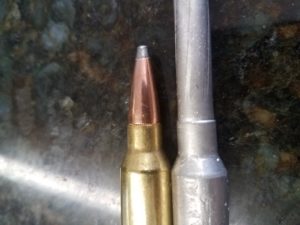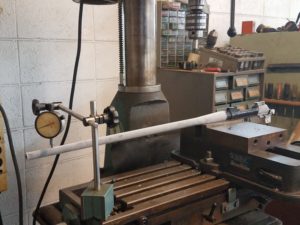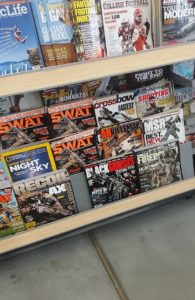Professional Scope Mounting
Don’t be deceived by what looks to be a simple job. Professional scope mounting takes training and a good working knowledge of gunsmithing to get the most out of the combination of gun, scope, mounts and ammo. Maybe the sporting goods store has a stock boy that can tighten down #6 screws tighter than the space shuttle’s gas cap but there is a lot more to this job than just making sure it is tight.
Let’s define a few terms before we go any farther to keep the confusion to a minimum
Ring- This is the round clamp that goes around the scope and has an arrangement on the bottom to attach it to the base.
Base- The small unit that attaches to the gun (usually with screw but not always) and provide a means for the ring to attach.
Eyepiece- the end of the scope next to shooters eye ( usually sharper than necessary!)
Objective end- The opposite end of the scope from the eyepiece. Measured in millimeters
Parallax- An error in viewing two object from different locations. Hold up your finger and look at the tip and the wall behind it, now move your eye around and the finger appears to move against the wall. This happens in the rifle scope when you look at a close target (like 25 yards) and move you head position on the comb of the stock. The crosshairs appear to move on the target. It can be adjusted to match the target distance or for most factory hunting scopes it is factory adjusted at 125 yards. It is basically a short range problem.
Picatinny- A military standard for a scope base similar to the weaver style. Weaver bases will attach to a Picatinny rail but Picatinny rings and devices will not fit on the Weaver base. If using a weaver ring on a Picatinny base it should be slide forward before the ring is tightened on the base. Even though weaver rings work this is not a desirable setup. Best to have the base match the ring. While originally a scope base these are used for almost any device being attached to a rifle like night vision equipment, flashlights or lasers.
Zero- A setting on the scope or sights that will align the aiming point and the strike of the bullet.
MOA- abbreviation for minute of angle. It equals roughly one inch at 100yards, two inches at 200, 5 inches at 500, and so forth. This also means it equals ½ inch at 50 yards, ¼ inch at 25 and so forth. So if your scope will move you ¼ minute per click then one click will move you 1/16 inch at 25 yards or 2.5 inches at 1000 yards. Read this over or draw it out with a straight edge or whatever you need to do but you have to understand MOA. When you want to move a scope that is centered 20 MOA to the left and the mounts are 3.8 inches apart it will require a good understanding of MOA!
Power- Usually denoted by a number followed by an X like 6X or many times in combination with the objective lens size like 6X42 would be a 6 power scope that has a 42 millimeter objective lens. Variable scopes have an adjustable setting and fixed scopes are only one power.
Collimator- A device to make a parallel line up. Used by the gunsmith to align the aiming point with the center of the bore. While it does not sight in the firearm it is a very useful tool allowing the gunsmith to see how precisely the scope adjustments move the aiming point and determine how much backlash is present.
Reticle- A system of fine lines used to aim. (Duh! It’s the crosshairs)
Mill Dot- A system of dots spaced on the reticle lines used to measure range.
Windage- Movement from left to right or horizontal
Elevation- Movement up and down or vertical.
Drop- usually a measurement in inches of the path of the bullet in relation to the line of sight reflecting the effect of gravity on the projectile.
Selecting the ring and base combination that is right for the job will be the first hurdle. A quick look at the current Brownells catalog reveals 20 pages of scope rings and bases. One piece, two piece, Weaver, Leupold, Picatinny, See-thru, Unertl and many more can make it hard for the person that doesn’t know what they want. Maybe we need to clarify just what a good scope mount should do. Hold the scope securely in line with the position of the eye when the gun is mounted to the shoulder and return to the same place (zero) if it is removed and reinstalled. Being adjustable so the scope adjustments can remain close to center would be nice too. Most of the available mounting systems have something to offer. The old Weaver mounts are solid and return close to zero, The Old Redfield system is harder to remove and return to zero but it is adjustable for windage.
After selecting take a look at what will be holding the bases to the firearm. In most instances it will be screws. Overwhelming favorite is the 6×48 with the 8×40 gaining ground. The 6 is a wire gauge size and the 48 is the number of threads per inch. These small screws have proven adequate for many years, however as firearms have become more powerful and scopes larger the effects of recoil that must be endured by the screws that are responsible for holding it all together have raised the strength requirements. Poor screw fit due to being too long or too short has created the majority of problems associated with scopes but it doesn’t end there. Screw head diameter and wrong threads have also been real pain for the gunsmith trying to turn out quality work. These problems are usually avoided by buying quality mounting products. Even if you buy the best it is still a good practice to inspect all the parts for defects before assembling on the gun. Look close and make sure threads are there and that they go all the way to the bottom of the hole. Try the screws in the holes and make sure they are not loose if you wiggle from side to side.
After you are satisfied with the fit and quality of the bases and the length and fit of the screws it is time to attach them to the gun. Take your time and snug each screw individually and then check the base for tightness to the gun. This step is important to make sure all the screws are actually holding the base to the gun and not coming tight without the head of the screw resting against the base. After you are satisfied each screw is performing like it should you can tighten. Judgment and experience are a great help here but nothing really beats a torque wrench. Thirty inch pounds is plenty of pressure with a 48 thread.
While I don’t prefer Loctite on my guns some of my customers swear they need it so I comply with their wishes. Personally I would rather be able to check screw tightness later and know the screw is actually tight against the base and not just being held by the Loctite in the threads.
If this is a custom job or a cobbled together arrangement I will use a long straight edge on the bases to check alignment with the end of the barrel. With the straight edge resting on both bases it should parallel the bore and be taking a path of its own. This is easy to see with the straight edge by the time it gets to the muzzle but a small misalignment is very hard to detect when the front and rear bases are only a couple inches apart.
Now we can cycle the action and make sure the action works freely. If any screws are protruding into the receiver and impinging on working parts you will probably feel it but close inspection is still warranted to make sure there is no contact with the bolt that might affect accuracy by disturbing alignment.
When all is well we can proceed to mounting the rings. I usually start with the front ring only and after mounting it snugly I will check ring height by placing the scope in the ring to make sure it clears the barrel. Then I use a long piece of round stock to check alignment with the bore. With the front ring in place the round stock which is no more than a long piece of aluminum rod long enough to extend from the rear of the receiver to the end of the barrel should be centered directly over the bore. If there is an alignment problem solve it by fitting or replacing before proceeding. Next the rear ring can be positioned using the round stock as a guide. Tighten the rear ring while watching the position of the round stock over the bore. It should not move. Again if there is an alignment problem solve it before continuing.
Now we have rings in line with the bore so they will they will not damage or kink the scope tube when they are tightened on the fragile scope tube. Another problem we are trying to avoid is placing any stress on the receiver from ring misalignment. This can be detrimental to accuracy just like a bedding problem would place stress on the receiver from beneath the action.
Now we have properly aligned and tight bases with rings in line with and parallel to the bore but we are still not quite ready to mount the scope. Our next job is make sure the individual bore of each ring is in alignment. We do this by lapping with a brass rod the size of the scope body (1 inch or 30 mm) coated with an abrasive lapping compound. The caps or tops are tightened only enough to contact the rod but allow movement so the twisting and front to rear movement of the lapping rod can proceed. When the two materials are rubbed together the abrasive will cut away the material in contact with the rod. If the rings are in perfect alignment (you wish!) the wear will show a pattern inside the ring of finish being removed on the entire surface. A normal result will be 20% of the finish removed after several minutes of lapping. For most installations getting the lapping above 60% will be a good fit. Since this is a fitting operation the rings and caps are now a fitted pair and should be marked in some manner to make sure they are not mismatched. This includes marking the cap not only as to which ring but also to prevent reversing the cap.
Whew! I told you it wasn’t easy but now you can clean off the lapping compound and mount the scope. All you have to do is get it straight in the rings and tighten without it moving and have it end up exactly where the customer wants it. Yes, in the end it is the customer that needs to be happy so with the job so at this point I usually leave the scope loose in the rings until the customer arrives to make the final determination as to how where it needs to be tightened. You might try to coach them a little by explaining the need for adequate eye relief and how if the scope is a little forward the head will come to a more consistent position on the stock and consistency leads to better shooting but in the end make the customer happy.
Using a scope reticle leveling device will stop a lot of disputes as you tighten the scope and hand it back and forth for the customer to check. These are fairly inexpensive and available from Brownells and others. Many people cant the gun without realizing it and nothing you can do will make them happy but putting the crosshairs level for them. Thankfully this isn’t a problem in most hunting situations since the distance is close and the target large in relation to a long range target and if the customer is a long range shooter they will already be schooled in the effects of misalignment.
This might seem like a lot of trouble but it really doesn’t take that much time after you have done a few and it just seems like a shame when all the work that went into an accurate rifle is compromised with a poor scope mounting job. I find writing up directions and handing out copies to customers that plan on mounting their own scope will generate a lot of scope jobs as the customer gains a better understanding of the importance of the job. As always, DO GOOD WORK!



